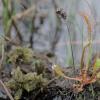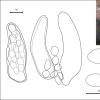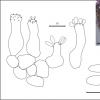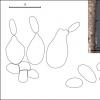
15-12-2025 15:48
 Danny Newman
Danny Newman
Melanospora cf. lagenaria on old, rotting, fallen

15-12-2025 15:54
 Johan Boonefaes
Johan Boonefaes
Unknown anamorph found on the ground in coastal sa

15-12-2025 21:11
 Hardware Tony
Hardware Tony
Small clavate hairs, negative croziers and IKI bb

15-12-2025 07:09
 Danny Newman
Danny Newman
indet. Rutstroemiaceae sp. on unk. fallen leavesMc

15-12-2025 07:05
 Danny Newman
Danny Newman
Pseudosclerococcum golindoi (det: Zotto)near Cosb

15-12-2025 11:49
 Danny Newman
Danny Newman
ITS sequences from the following two collections B

15-12-2025 12:34
 Danny Newman
Danny Newman
indet. Rhytismataceae on oak leafnear Purchase Roa

09-12-2025 12:06
 Andgelo Mombert
Andgelo Mombert
Bonjour,Je recherche l'article concernant Hypobryo
A carnivorous plant, sundew (Drosera anglica, D. rotundifolia) may have some special biochemical composition and accordingly adapted to it fungal community. I collected four morpho-species from this plant so far. Though its leaves are thick and there are many of them in the litter, they were. All collected species were growing at flowering shoots and at fruits. Probably, digestive enzymes in leaf drops ("due") could be repellent to fungi.
One common enough here species is a Mycosphaerella. The perithecia are very tiny, up to 100 mk and barely visible. But there are mature asci and two-celled hyaline spores inside, in reward for the tedious work with such a small objects. (#4204 - https://www.cubby.com/pl/%234204/_6eca9336e9e841359e9ced422c8bcf11)
Some relative of Bortytis was spotted after the short incubation in a wet chamber.(#4201 - https://www.cubby.com/pl/%234201/_ca45a85a098d43a5b7e6de51328c4cac)
Another anamorphic species with surprising look was revealed at the scale of a fruit. Clavate conidiogenous cells bear at its tips several ellipsoid conidia. (#4205 - https://www.cubby.com/pl/%234205/_a06c63f7ce7d4c46b533d8d9769c6919)
The last morpho-species is again anamorphic. Small perithecioid structures were spotted in upper part of a stem. They filled with drop-shaped conidiogenous cells, from upper narrowed part of those arise ellipsoid conidia. And look at the photo: obviously, this dinosaur threatens to our fungus ). (#4207 - https://www.cubby.com/pl/%234207/_fd8ac1df758742e2baa9e219b70a88ee)?





